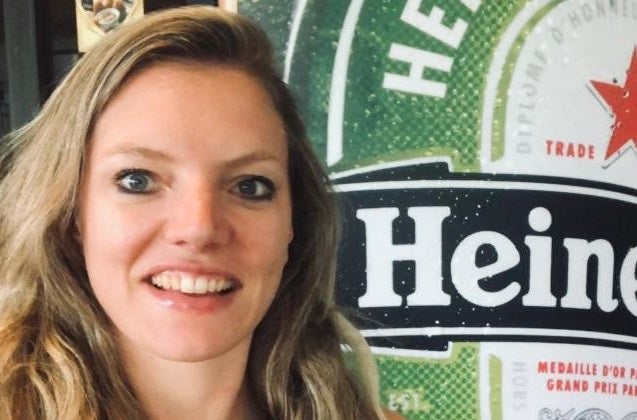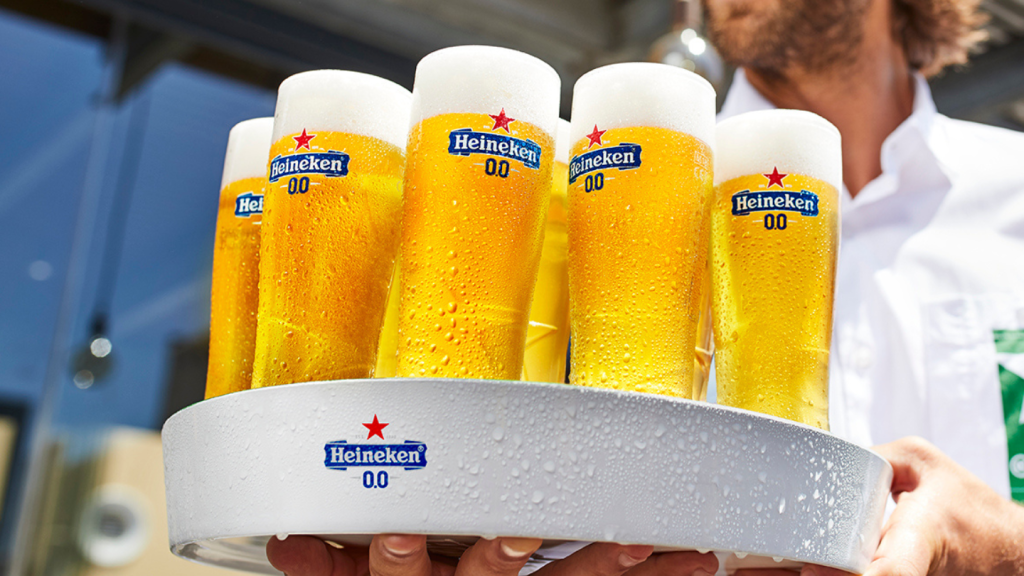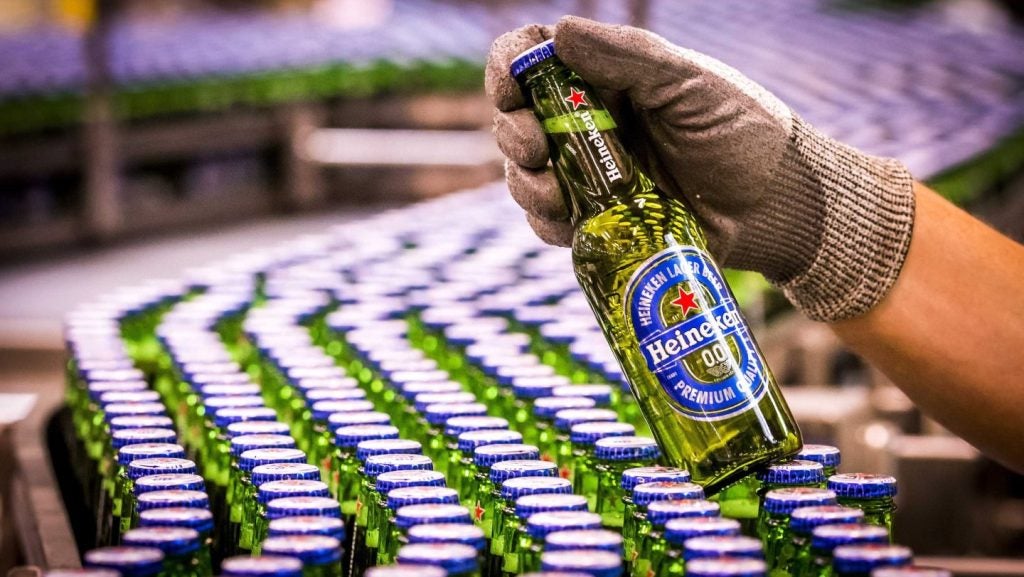Heineken 0.0 is one of the biggest non-alcoholic beer brands in the world. The 0.05% abv beer was first launched in 2017 in the Netherlands and Germany and has since spread to more than 110 markets.
In October, the Dutch giant said alcohol-free beer needs to account for at least 10% of global beer sales to become an established form of consumption.
Following the Non-Alcoholic Beverage Strategies conference in Barcelona earlier this month, Just Drinks sat down with Karlijn Van Ruiten, Heineken's global innovation manager, to discuss some of the chief areas of concern for the company’s flagship non-alcoholic beer, the category more widely and why getting on draught is so vital for the sphere.
Just Drinks: How would you summarise the demand for non-alcoholic beer in Europe?
Karlijn Van Ruiten: I think in Europe we have seen the biggest growth until now for the 0.0 category, right? If you look at it from a GlobalData point of view, we see that non-alcoholic beer is 4% of beer in Europe, which is the biggest share of the four regions. But, within Europe, there are a lot of differences. Taking the UK, for example, the UK is less developed on 0.0 beer than the Netherlands or Spain. Spain already shows that the category has been there for over 30 years and half of people drinking beer are drinking non-alc beer. That’s something that you also see in the Netherlands, when it comes to people drinking it, and that also is reflected in the share of non-alcoholic beer in beer.
But that also means that at a certain level, especially in off-trade, you see the growth not flattening but let’s say forecasted between 2% and 5% growth. That is just the off-trade because we don’t have a lot of data on the on-trade. When you look at the UK, I would say the growth can still be double-digit because they just are not yet at the level where Spain and the Netherlands are.
Just Drinks: Which markets are spearheading the growth in Europe?
Van Ruiten: Generally, I think you see that it is a growing category in terms of penetration, so people consuming it but also in terms of like volume sold. What I do see in the Netherlands though, is that the shelf we have in the Netherlands is quite impressive. The variety of flavours of craft, lager, 0.0. I think that’s a brilliant example case.
Same goes for Germany, same for Spain. If you look at our top European markets, I would highlight those three. Then you also have some eastern European markets like Slovakia, Hungary, which also have a really high share, but they’re influenced by 0.0 beer mixes. They have a lot of flavour variety there. Poland is also one of them. That’s a different story, I would say a little bit because it’s really driven by flavoured 0.0.
Just Drinks: You mentioned during the conference that ‘Tostadas’ were seeing strong growth in Spain, can you expand on that?
Van Ruiten: We just know out of the figures that the sub-segment of the Tostada 0.0 is outgrowing the sub-segment of 0.0 wheat beer, 0.0 lager and even flavoured 0.0 beer. So that is quite impressive.
You do see that innovation has always been the driver of the 0.0 category in Spain. We were one of them and so when Heineken 0.0 and 0.0 lager innovated then there was a big peak. Then there was this Tostada subcategory that really made new news within the category.
Just Drinks: Has the on-premise market proved harder to crack than expected?
Van Ruiten: You can get a bottle in on-trade everywhere but it’s more or less the challenge of being on draught which we are facing as a category. When a keg is open, alcohol-free beer could ferment and create alcohol if you don't treat it well. You need to make sure that you are absolutely using the right dispense solution for alcohol-free beer to eliminate this risk. And of course, we as the global leader of 0.0, we’re the biggest brand of 0.0 beer. We want to make sure that we do it right.
We have multiple draught solutions. One of them is the “Blade”, a closed system. It’s a cold system, no bacteria is going to enter. We know this is the safest for eliminating the risk of fermentation in having an alcohol-free beer. The same goes with “David”, which is another system that we have under our solution. Those you see already on a big scale. Ireland’s really a front-runner on the “Blade”. The Netherlands is really a front-runner on the “David” but there are no draught solutions without obstacles, right? People find it too expensive for customers or whatever.
We have another solution, which is called “Bluebird”, and that's an internal name by the way, and that's a solution that we developed three years ago in which we are able to prevent potential bacteria from entering the keg in an innovative way.
So those are a few examples of what we are doing to really make sure that 0.0 on draught can grow because personally, I believe you want to offer a drink in the most relevant SKU or most relevant formats. Take the UK, for example. It’s a draught market, I think over 90% of volume in the UK is draughted in the on-trade. That means that you really need to be there in the most relevant SKU because people order them in draught so it’s important.

Personally, I think if you see it on-shelf and, we know this also from research in the Netherlands on users and attitudes, people feel less social stigma ordering it when it’s on draught. If you see it in a bar and it’s like in your face next to a Heineken, next to an IPA, next to whatever other beer you have on the columns, it feels super logical to order it and you are one of the people in the bar and drinks a beer because it comes from draught column. So I think that is why I believe personally it can be such a big unlocker, not even maybe in terms of volume, but in terms of normalising alcohol-free beer for the category, I think it is really an unlocker.
Just Drinks: How are Heineken’s non-alcoholic beer markets outside Europe?
Van Ruiten: Well, I think you’ll see the biggest growth is now in the Americas region. There you still have a double-digit growth on the category. One of the examples is Mexico where we have just launched Tecate 0.0, of which I showed the commercial [at the conference] which really made it fly because Tecate is a really big brand. And the same goes for Brazil. In Brazil, the category is growing really, really fast and there are also a lot of competitors going after it so that helps.
Some markets in the Americas can definitely reach the European point. APAC, I would have my conservative thoughts
I really am a portfolio thinker. I really would like for us together to grow the pie and for everybody to have a piece instead of being the number one but then you’re not growing. I think some markets in the Americas region can definitely reach the European point. APAC, I would have my conservative thoughts. Because, as I shared before, the Japanese proverb saying the nail that sticks out gets hammered down. It really needs consumer behaviour change because they’re super influenced by group decisions, less individualistic, I would say than we are here in Europe.
Just Drinks: You recently launched Heineken 0.0 in Japan – how have the first six months been there?
Van Ruiten: We never share results on a market level but I can share that Japan is the second-biggest zero-alcohol beer market, so we do foresee that if we can get a piece of that pie, it can be a big piece.
Just Drinks: Is Europe the main priority market for Heineken 0.0 currently?
Van Ruiten: I think we look at our top 15 markets, which also represent 80% of our total volume, so we really want to stay focused on our key white spots.
Just Drinks: Is there room for innovation for Heineken 0.0 as a brand?
Van Ruiten: Yes, definitely. That is something that we’re looking into. Whether it will see the light of day, you will never know because that depends on how innovation is developed. We do a lot of testing pilots. But we also want to stay ahead because we are the leader of the category.
Just Drinks: Have you found any difficulty in attracting young consumers toward alcohol-free beer?
Van Ruiten: There is no one answer to this because it really depends market by market. And that really depends also on the brand strength of Heineken in a market. Looking at Brazil, we see 0.0 growing on each age level, because Heineken is super strong in Brazil, so there we don’t see that it’s not relevant for Gen Z.

I think I compared it nicely to washing powder. My mum used washing powder and I have never used washing powder because, when I moved to my own household, there was more innovation in the category of washing detergents. So I use caps. That is my knowledge, right? Then my children will probably have innovation within that and they will not even know about caps anymore, right? So I think in general, what I am trying to say is that innovation is just so crucial to also attract people to the category.
So I think from a flavour profile, you could see that there’s your beer drinkers who also mostly like beer but it’s not to say that a Gen Z person who has never tried a beer now tries a 0.0 beer will not like it. Within the category of 0.0 beer, there’s so much variance in taste.
if you are interested in non-alcoholic drinks or alcohol-free, it’s not to say you always want 0.0
Just Drinks: How do you feel about alcohol-free labelling legislation and can you see it hindering the category’s wider growth?
Van Ruiten: What I think is more important is education to consumers. You just want to be clear on what you’re drinking, whether you are a 0.0 or 0.5 [% abv]. In Spain, there’s even a category called “sin” which is 0.9%. I think to be honest, if you are interested in non-alcoholic drinks or alcohol-free, it’s not to say that you always want 0.0. You can also just want to drink less alcohol but you’re happy with 0.5%, or happy with 0.9% or even happy with the 2% if you don’t really care about the alcohol but would rather get rid of calories or whatever. So I think it's just about education. That’s for me the most important one: that everybody is clear on what they’re drinking and what is in the pack.
Then, in the end, we can grow together, right? I mean, for me, it’s not like it’s in a box or something [about which] you really need to be 100% strict. That’s not how I would look at it. I would just say it is a trend that people want to maybe consume less alcohol. Then it’s up to them to decide what their guardrails are. I also learned that a lot of people at the conference said to me, do you know if you drink orange juice that it is already 0.05% abv? So it’s also a lot of people are not aware of what the current situation is.
--
Interested in knowing more about the beer industry and meeting industry leaders including Carlsberg, Asahi, AB InBev, Mahou San Miguel, Bitburger Braugruppe and Super Bock? Join us in Porto on 14 -16 May for the International Beer Strategies Conference.









